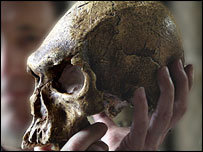
At least that is what the article says, though maybe they photographed a Neanderthal skull in error.
On the other hand, Erectus walks among us gives an example of an almost equally primitive looking aboriginal skull, and suggests that our most recent common ancestor with the Australian aboriginals is not very recent.

The difference seems to be at least as great, as the difference between a human skull and a Neanderthal skull, and the cranial capacity of the Neanderthal skull considerably greater. Observe the sloping brow and the ridges surrounding the eye sockets, very similar to what makes a Neanderthal skull Neanderthal. Indeed, I wonder if this is a Neanderthal skull somehow mislabeled.
If, as seems likely, Neanderthals had very limited interfertility with humans, we would, on the face of it, suspect that Tasmanians would have very limited interfertility than humans, assuming the skull to be correct, and, from cranial capacity, a substantially lower technological capacity than Neanderthals. In fact, however, Tasmanian technology was better than Neanderthal. Tasmanian art was about the same as Neanderthal art.
Aboriginal skull images have been floating around the far right for years, lefties always respond that they are fake or mislabeled, and nobody ever manages to give a respectable source for them. Of course, no source supporting such flagrant and heinous crimethink could hope to remain respectable, but I still want to see some relic that survived the purge, or at least some evidence that there was a purge.
Well, I gave you the link, which is in a Cathedral source.
And the link points to a plan to destroy the skull in question.
For posterity, I have attempted to make an archive backup in case the BBC removes the article:
http://news.bbc.co.uk/2/hi/uk_news/england/oxfordshire/6647547.stm -> https://archive.today/Yav5z
Interestingly, there don’t seem to have been a lot of interfertility issues with Aborigines/Europeans (as evidenced by the tons of mixing and descendants surviving to this day,) although they split at least 50KYA (I’d guess more.)
Interfertility doesn’t have to be linearly related to time since a split took place. A trait like a different rhesus type or a change in cranial/pelvic size can emerge in a short period, make a sweep through a subpopulation, and you’ve got interfertility issues. At the same time, an adjacent subpopulation which split from the source one much longer ago could stay interfertile. For instance, Tibetan mastiffs and shih tzus are probably much closer related than Tibetan mastiffs and huskies. But the mastiffs and shih tzus are not interfertile.
There are in fact two races of mainland aboriginals, or recently were – one is the inland aboriginals, primitive caucasoid, resembling the distant ancestors of whites, one is “Coastal aboriginal”, skull is conspicuously primitive. Seems to have pretty much died out.
These two races remained distinguishable despite inhabiting the same continent for fifty thousand years, hence probably have very limited interfertility. Indeed, even though being equally oppressed victims of the white colonialist oppressors leads to them being defined as one race, remaining clearly distinct despite overlapping geographically means that they clearly meet the standard definition of distinct species.
That the desert aboriginals (primitive caucusoids, blond haired and light brown when children) are interfertile with modern type caucasoids is obvious.
If the desert aboriginals were less primitive than the coastal ones, why did they not take over from them? The coast is a nicer place to live than the desert, no?
Not necessarily less primitive. More closely related to Caucasians.
It’s pretty obvious that all human races are the same species. Otherwise, how could we all enjoy music, which is pure Platonic harmony and an expression of the ideal which we hope to attain? Compare:
https://www.youtube.com/watch?v=0zlPe9g1Fvw
vs.
http://youtu.be/6g5ZF6DUrHI
QED
That BBC article is basically a worship ceremony of the UK state religion of leftoidology. How much more sensitive to the tribesmen can they get.
Well, you might be on to something.
“New genetic analysis indicates that Australian Aboriginals, at least those in the northern part of Australia, picked up about 11% of their ancestry from India, relatively recently – about 140 generations ago. 4000-5000 years, depending on generation length.”
http://westhunt.wordpress.com/2013/01/15/a-three-hour-tour/
And Indians would have been…at least partially…Ancestral South Indian.
And Ancestral South Indians were small dark people most closely related to Negritos and ssignificantly related to..Australian aborigines.
We now know that humans left African in two waves:
The first wave of migrations probably followed the southern coast of the Arabian Peninsula as early as 130,000 years ago to Australia and the west Pacific region, while the second wave traveled along the northern route about 50,000 years ago, the researchers said. These waves of migration appear relatively isolated from each other.
“Australian Aborigines, Papuans and Melanesians were relatively isolated after the early dispersal along the southern route,
http://www.livescience.com/44988-humans-dispersed-earlier-than-thought.html
The Ancestral South Indians were part of that earlier wave, but they were not genetically isolated because of their location and proximity to second wave humans.
This gives some interesting context to the situation in Australia and Tasmania.
First wave humans extensively mixed with non-isolated second wave humans in India and then traveled to Australia, introducing a small amount of second wave DNA there. The result was less divergence between Australians and everyone else.
But in Tasmania second wave humans remained genetically isolated. And there do appear to have been some fertility problems when they hybridized with pure second wave humans.
And remember, per Jared Diamond:
“Unlike mainland Aboriginal Australians, Tasmanians couldn’t start a fire; they had no boomerangs, spear throwers, or shields; they had no bone tools, no specialized stone tools, and no compound tools like an axe head mounted on a handle; they couldn’t cut down a tree or hollow out a canoe; they lacked sewing to make sewn clothing, despite Tasmania’s cold winter climate with snow; and, incredibly, though they lived mostly on the sea coast, the Tasmanians didn’t catch or eat fish. ”
Whoa.
“They couldn’t cut down a tree or hollow out a canoe.” God damn, how the hell do you think the got to Tasmania in the first place? Did they swim?
Nevermind.
Probably where there when it sea levels were lower.
Yup:
https://i.pinimg.com/originals/cf/5e/19/cf5e19a966f568c9e89cb5dd2fe0df63.jpg
Jared is partially incorrect actually.
Tasmanian Aboriginal tribes did have some of those technologies such as specialised stone tools and could start fire. sewing has been present then later lost as was fishing in favor of collecting shellfish as an easier option. They also made bark canoes. but they migrated while there was a land bridge present from mainland to tasmania.
Jim, what is the exact racial connection between South Indians, basically Dravidians, and Australoids? Dravidians ARE Australoids, right?
Pretty sure Dravidians are not Australoids.
Some anthropologists classify them as such, others don’t.
Anthropology is a collection of pleasant politically correct fictions.
There are some questions that can only be settled when we resurrect Joseph Mengele by putting his brain in the body of one Jewish twin and putting in his mouth a Torah scroll written on the other twin’s skin. He can do the obvious DNA test and we can trust his result.